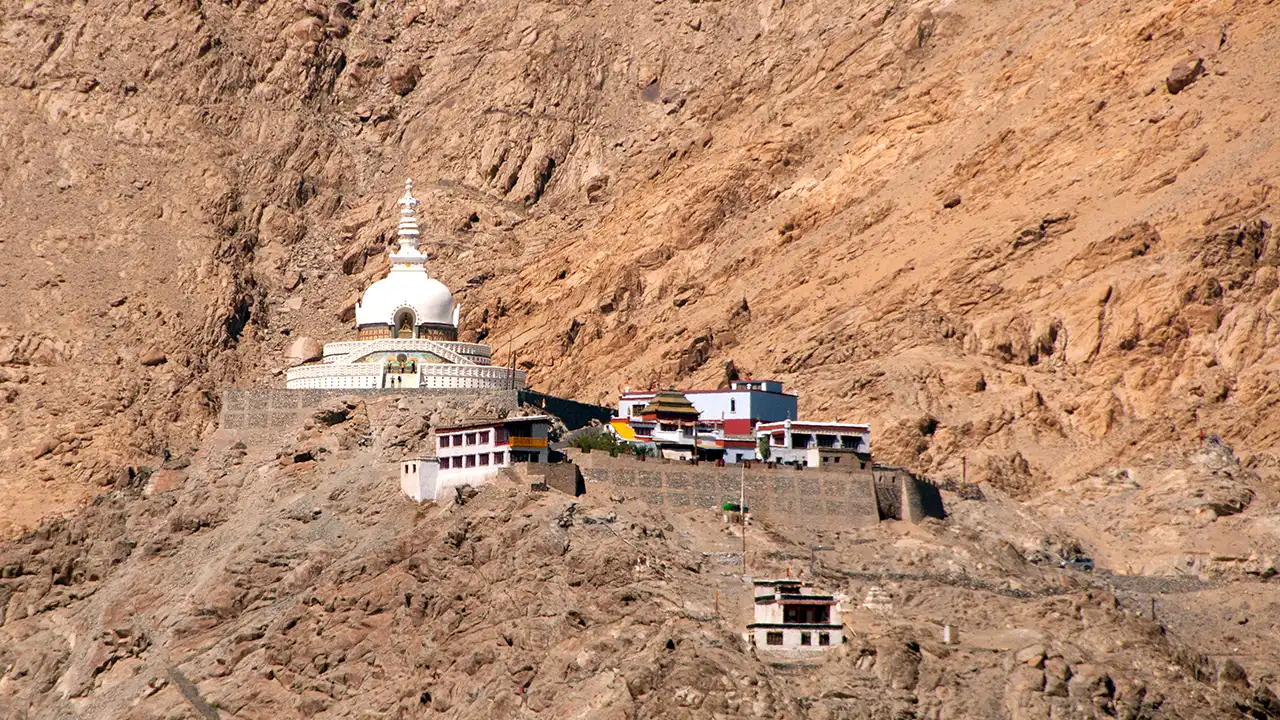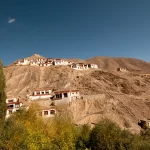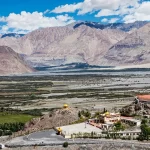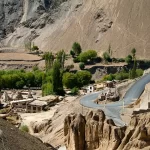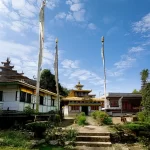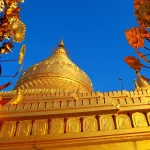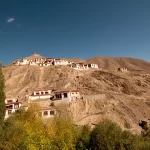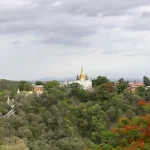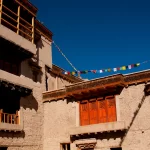Located amidst the rugged, stunningly gorgeous landscapes of Ladakh’s Nubra Valley, Diskit Monastery is not just the oldest and largest Buddhist monastery in the region—it is a profound symbol of Himalayan spirituality, heritage, and peace. Cozied in the midst of unforgiving mountains and Shyok River, Diskit Monastery is a pilgrimage center for devout travelers and adventurous seekers. Known for its geographical vantage, centuries-old paintings, and colossal figure of Maitreya Buddha, the monastery continues to be an important site for the maintenance of rich religious and cultural traditions of Ladakh.
Historical Background
Diskit Monastery was established in the 14th century, circa 1420, by Changzem Tserab Zangpo, a pupil of Tsongkhapa, founder of the Gelugpa (Yellow Hat) school of Tibetan Buddhism. Its establishment signified the dissemination of Gelugpa teachings in the Nubra valley, which had earlier been dominated by earlier schools of Tibetan Buddhism.
Though situated far away from Tibet’s religious centers, Diskit became a powerful symbol of religious influence in the region. It was strategically placed historically as well because Nubra Valley was also on the old Silk Route. Merchants and pilgrims on their way from Tibet, Central Asia, and India would stop at Diskit quite often, and thus Diskit became a center of scholarship and diplomacy.
The monastery was then put under the management of Thiksey Monastery, a larger and politically influential monastery near Leh. In the present times, the affiliation continues to exist with Thiksey acting as Diskit’s administrative and spiritual head.
Architecture and Layout
Diskit Monastery is dramatically built on a hill that looms above the village of Diskit, offering a panoramic view of the Nubra Valley.Its monastic building style in Ladakhi is typical—mud-brick walls, whitewashed façades, and wooden balconies.The monastery complex sprawls over several levels of the stone hill, providing an impression of stacked spirituality.
Inside it is surrounded by the rest of the buildings is the main prayer hall (Dukhang), which houses a statue of Crowned Buddha (Maitreya) and beautifully detailed frescoes that depict scenes of Buddhist mythology. Ancient texts, thangkas (scroll paintings of Tibet), and ritual items are housed in various chambers and shrines.
The monastery also possesses a Gon Khang, or temple of guardian deities, with fierce protector deities that have faces meant to repel evil. These images are normally kept hidden from the general public and observed only by initiated monks and pilgrims.
The Maitreya Buddha Statue
One of the most visible draws of Diskit Monastery is the 106-foot Maitreya Buddha statue, built in 2010 and inaugurated by the Dalai Lama. Perched on a hill overlooking the Shyok River, this gargantuan statue is not a part of the original monastery complex but is now one of its most visited sights
The statue was built with the aim of fostering world peace and safeguarding the area against war and natural disasters, particularly considering Nubra Valley’s proximity to sensitive border regions. Constructed using locally available material and donated money, the statue symbolizes the dedication of the locals and adherence to Buddhism.
Looking out over the valley at Pakistan, the statue is also a symbol of hope, compassion, and unity in a geopolitically volatile region.
Monastic Life and Education
Diskit Monastery accommodates about 100 monks, who live according to Gelugpa regulations. Their routine consists of meditation, scriptural study, rituals, and work for the benefit of the people. Like in other Ladakhi monasteries, Diskit is a religious as well as an educational institution.
The monastery has a monastic school where students are provided with training in Buddhist philosophy, Tibetan language, and ritual behavior. In recent times, the curriculum has been enriched with modern subjects such as mathematics, science, and English, typically imparted by the assistance of NGOs and voluntary teachers.
Such a combination of ancient and modern education makes the next generation of monks capable of maintaining their heritage while transitioning into present-day issues.
Dosmoche Festival
Perhaps the most colorful celebration that takes place at Diskit Monastery is the Dosmoche Festival, which occurs each year in February. It is also referred to as the “Festival of the Scapegoat.” Dosmoche is an age-old ritual practiced to chase away evil spirits and bring good fortune to the land.
The festival’s grandeur is the Cham Dance, a masked ritual dance by monks, set against music and chanting. The dances illustrate Buddhist gods and demons and are performed in elaborate costumes with symbolic movements narrating stories of spiritual victory over evil.
Locals from nearby villages visit to participate, transforming the otherwise peaceful monastery into a hub of color, noise, and passion.
Cultural and Regional Significance
Diskit Monastery is not only a sacred place but a cultural stronghold of Nubra Valley. It is a reservoir of spiritual inspiration, learning, and social harmony among the local populace. The monastery also tries to settle issues at the local level, advising people according to Buddhist ethical doctrines.
In an area of crumbling infrastructure and difficult living conditions, Diskit Monastery is a haven, not only for monks but for the community at large. It exists in other areas such as healthcare, education, and cultural conservation too.
Tourism and Accessibility
As with the growing popularity of Ladakh as a destination for holidays, Diskit Monastery is becoming one of the prime tourist hotspots. Being close to Hundar’s sand dunes and the Shyok River, it makes a perfect visit on the Leh-Nubra Valley loop.
The drive from Leh to Diskit, over Khardung La Pass—among the world’s highest motorable roads—is an added excitement. The scenery includes snow-covered peaks, desert scenery, and alpine grasslands.
Tourists are received warmly at the monastery and can visit prayer sessions, walk around the grounds, and interact with the monks. The monastic leadership and local administration promote responsible tourism, with an emphasis on respect for cultural traditions and the sensitive environment.
Cultural and Regional Significance
Diskit Monastery is not just a holy site but a cultural bastion of Nubra Valley. It is a pool of spiritual inspiration, education, and social harmony among the locals. The monastery also attempts to resolve disputes at the local level, guiding people based on Buddhist ethical principles.
In a part of deteriorated infrastructure and difficult living, Diskit Monastery is an oasis, not only for the monks but also for the general populace. It exists in other areas such as healthcare, education, and culture preservation as well.The dances depict Buddhist demons and gods and are danced in ornate costumes with symbolic gestures recounting tales of spiritual triumph over evil.
Locals from surrounding villages come to join in, turning the otherwise serene monastery into a center of color, noise, and fervor.

